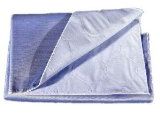There comes a time when reality becomes an issue with eldercare. For whatever reason, a person for whom you care for has a problem with elderly incontinence. You want to maintain the dignity of the older person, but you must protect the mattress as well. What can you do?
Waterproof bed pads are a good choice both for their easy use and for their adaptability. Placed where the elder inconvenient person lies on the pad to sleep and the pad will absorb the “leakage” before there is a problem. To change the pad you simply throw away the wet one and replace it with a fresh, dry pad. A pad can be placed in a lift chair before the elder person sits down and then changed as needed without having to turn the cushions or having spare cushions for the chair.
Waterproof Bed Sheets
 Another choice for elder protection is waterproof bed sheets. These are fitted sheets that are used on the bed just as a regular sheet. The advantages are that the waterproof sheets will keep the mattress dry regardless of whether the elderly person tosses and turns in their sleep since they can’t roll off the sheet, and that the sheet won’t bunch up under the person making them uncomfortable. The disadvantage is that the sheet must be cleaned after every leakage. Always look for a bed cover that protects your expensive mattress or handicap bed. Hospital grade vinyl that is antibacterial as well as waterproof can be wiped clean when necessary.
Another choice for elder protection is waterproof bed sheets. These are fitted sheets that are used on the bed just as a regular sheet. The advantages are that the waterproof sheets will keep the mattress dry regardless of whether the elderly person tosses and turns in their sleep since they can’t roll off the sheet, and that the sheet won’t bunch up under the person making them uncomfortable. The disadvantage is that the sheet must be cleaned after every leakage. Always look for a bed cover that protects your expensive mattress or handicap bed. Hospital grade vinyl that is antibacterial as well as waterproof can be wiped clean when necessary.
A possible problem with waterproof sheets may be that they “crinkle” as the sleeper turns in their sleep possibly causing a sleep disruption. Also, the waterproof sheet will not absorb the urine. A solution to each of these problems would be to use both the sheeting and the bed pad at the same time. The pad both muffles the sound and absorbs the urine while the sheeting protects the bed. Each situation can be different but these products used separately or in tandem are good solutions for elderly incontinence problems while effectively maintaining the individual’s dignity.
